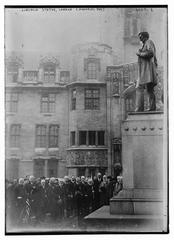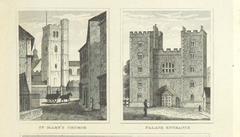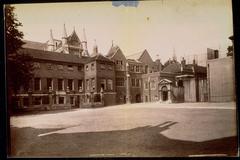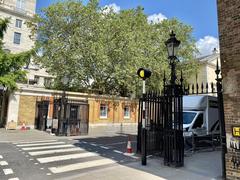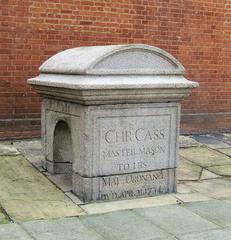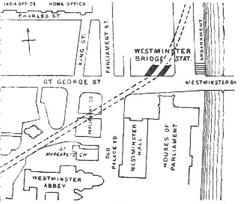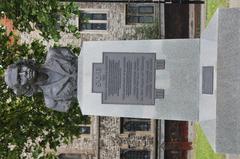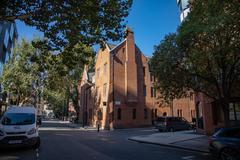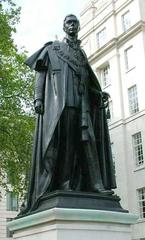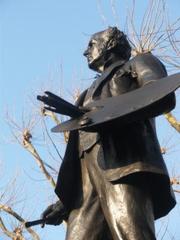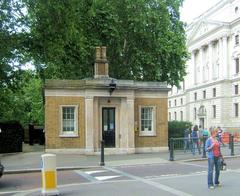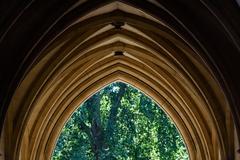Duck Island Cottage: Visiting Hours, Tickets, and Historical Significance in Kingston Upon Thames
Date: 14/06/2025
Introduction to Duck Island Cottage in Kingston Upon Thames
Nestled along the peaceful banks of the River Thames in Kingston Upon Thames, Duck Island Cottage is a striking example of Victorian “cottage orné” architecture and reflects the town’s deep historical roots. Distinct from its London namesake in St James’s Park, Kingston’s Duck Island Cottage is cherished for its ornate timber-framed design, decorative bargeboards, and tranquil riverside setting. The cottage stands as a symbol of the town’s centuries-old connection to the Thames, offering a unique lens into the area’s royal past and vibrant community life (Kingston upon Thames Historical Sites).
While the cottage is a private residence and not open for interior tours, its exterior can be admired year-round from the scenic Thames Path. Its proximity to landmarks like Clattern Bridge, the Coronation Stone, and Canbury Gardens further enriches the visitor experience, making Duck Island Cottage a rewarding stop for history enthusiasts, architecture admirers, and casual explorers alike (A Lady in London).
Table of Contents
- Discover Duck Island Cottage: A Riverside Gem
- Early History and Origins
- Architectural Features and Development
- Historical Significance in Kingston’s Heritage
- Role in Local Culture and Community
- Conservation and Modern-Day Relevance
- Visiting Duck Island Cottage: Hours, Tickets & Accessibility
- Notable Events and Guided Tours
- Related Sites and Further Exploration
- Frequently Asked Questions (FAQs)
- Conclusion
- References and Further Reading
Discover Duck Island Cottage: A Riverside Gem
Duck Island Cottage is one of Kingston Upon Thames’s most picturesque landmarks, encapsulating the town’s rich architectural and riverside heritage. This guide covers its historical background, architectural significance, practical visitor information, and its role in Kingston’s broader cultural landscape.
Early History and Origins
Kingston’s Duck Island Cottage is a product of Victorian fascination with rustic, decorative architecture. While easily confused with the more famous Duck Island Cottage in St James’s Park, London, Kingston’s version is rooted in its own unique local history. The town itself, first recorded in 838 AD as “Cyninges tun” or “King’s Estate”, has long been a hub of royal and civic activity. Its riverside location was historically vital for trade, defense, and ceremonial events, with the Thames serving as both a barrier and a thoroughfare (Kingston upon Thames history).
Architectural Features and Development
Duck Island Cottage exemplifies the “cottage orné” style, popular in 19th-century England for its romanticized, rural charm. Typical features include:
- Timber-framed construction
- Ornate bargeboards and decorative woodwork
- Steeply pitched roof
- Picturesque riverside setting
The cottage’s location by the Thames and close to the Hogsmill River, near the ancient Clattern Bridge, reflects both its aesthetic and practical significance. The surrounding area teems with wildlife and is a favorite among local artists and photographers (Clattern Bridge).
Historical Significance in Kingston’s Heritage
Duck Island Cottage stands as a tangible link between Kingston’s medieval and Victorian pasts. The riverside, where the cottage is found, has witnessed significant historical moments, including the coronation of several Anglo-Saxon kings at nearby All Saints Church and the Coronation Stone (Coronation Stone). Preservation of the cottage underscores Kingston’s commitment to safeguarding its unique historical and architectural legacy.
Role in Local Culture and Community
Although Duck Island Cottage is not open for public tours, it plays an important role in Kingston’s cultural landscape. Its distinctive appearance and tranquil riverside location make it a popular subject for local artists and photographers. The cottage is part of a constellation of historical sites, including All Saints Church, the Ancient Market Place, and the Druids Head pub, each contributing to Kingston’s vibrant sense of history (Kingston’s historic buildings).
Conservation and Modern-Day Relevance
Kingston places a strong emphasis on the conservation of its historical assets. The careful preservation of Duck Island Cottage and related sites like Clattern Bridge and the Coronation Stone reflects ongoing efforts to maintain Kingston’s character and support heritage tourism (Coronation Stone move). The cottage’s continued presence along the Thames Path ensures it remains accessible and relevant to new generations of visitors.
Visiting Duck Island Cottage: Hours, Tickets & Accessibility
Visiting Hours:
Duck Island Cottage is visible from the Thames Path and public areas year-round. While the property itself is private, visitors can enjoy its exterior at any time.
Tickets and Entry:
There is no entry fee or ticket required to view Duck Island Cottage from public paths.
Accessibility:
The surrounding Thames Path is mostly flat and suitable for wheelchairs and strollers, though some riverside areas may have uneven ground. Benches and resting spots are available nearby.
Getting There:
- By Train: Kingston railway station is a short walk from the riverside; direct trains run from London Waterloo.
- By Bus: Numerous routes serve Kingston town center.
- By Bike: The Thames Path is cycle-friendly.
- By Boat: River cruises depart from Kingston and offer picturesque views of the riverside (Mummy Travels).
Travel Tips:
- Best viewed in early morning or late afternoon for ideal light and fewer crowds.
- Respect the privacy of the residents—do not attempt to enter the property.
- Canbury Gardens nearby is perfect for picnics and riverside relaxation.
Notable Events and Guided Tours
While Duck Island Cottage itself does not host events or regular tours, it is frequently featured as a highlight during local historical walks and heritage tours organized by Kingston’s visitor center and heritage groups. These events explore the town’s rich past and often include stops at the cottage, Clattern Bridge, and the Coronation Stone.
Related Sites and Further Exploration
Kingston Upon Thames is home to several other notable historic attractions:
- All Saints Church: Central to Kingston’s spiritual and civic life since the 12th century.
- Coronation Stone: Ancient Sarsen stone linked to the coronation of Anglo-Saxon kings.
- Ancient Market Place: Historic commercial center featuring the Market House and Shrubsole Fountain.
- Druids Head Pub: The oldest pub in Kingston, dating to the early 16th century.
- Clattern Bridge: One of England’s oldest intact bridges, dating to around 1200.
Each site offers insights into Kingston’s layered history and is easily accessible from Duck Island Cottage (Kingston’s historical gems).
Frequently Asked Questions (FAQs)
Q: What are Duck Island Cottage visiting hours?
A: The cottage can be viewed from public paths at any time; there are no restricted hours.
Q: Is there an entry fee or ticket required?
A: No, it is free to view Duck Island Cottage from the riverside.
Q: Are guided tours available?
A: While no tours focus solely on the cottage, many local heritage walks include it as a key site.
Q: Is the site accessible for visitors with disabilities?
A: The Thames Path is mostly accessible, though some areas may be uneven.
Q: Can I take photographs at Duck Island Cottage?
A: Yes, photography of the exterior from public areas is encouraged.
Q: How do I get to Duck Island Cottage using public transport?
A: Kingston railway station and local bus routes offer convenient access; the cottage is a short walk from the town center.
Conclusion
Duck Island Cottage in Kingston Upon Thames is a treasured riverside landmark that beautifully embodies Victorian architectural charm and the town’s royal heritage. Though not open for public tours, its exterior is freely accessible along the Thames Path, making it a must-see for visitors interested in Kingston’s history, architecture, and natural beauty. Take advantage of the surrounding riverside walks, nearby attractions, and local events to fully experience this enchanting area. To enhance your visit, download the Audiala app for interactive maps and guided tours, and follow us on social media for the latest updates on Kingston’s historical treasures.
Alt text: Duck Island Cottage timber-framed exterior by the River Thames in Kingston Upon Thames
For more information on Kingston’s historical sites and visitor resources, visit the official Kingston upon Thames guide.
